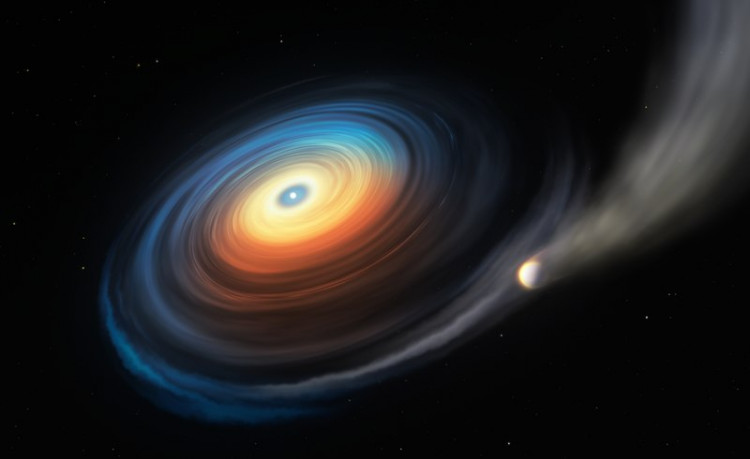As with other objects in the universe, white dwarfs are made of charged particles. They are also fairly small, and they spin pretty hard. The fast-spinning charged particles create magnetic fields that fan out well beyond the white dwarf's surface and influence how the material from its companion star eventually makes it to the white dwarf's surface.
If the magnetic fields of the white dwarf star are weak, the hydrogen from its companion star settles down into a good, regular accretion disk, feeding steadily onto the white dwarf. If the magnetic fields are powerful, they funnel the gas into streams that loop around the white dwarf and hit the poles, like a supercharged aurora borealis.
But if the magnetic fields are intermediate - not too weak but not too solid - that's what is known as "intermediate polar." The word "polar" pertains to the magnetic field structure itself. In this scenario, the magnetic fields are not strong enough to interrupt the creation of an accretion disk entirely, but they are sufficiently beefy to twist the gas around the white dwarf. This prevents a normal, smooth gas flow, which irregularly and unpredictably causes the white dwarf to flicker and flare.
A team of astronomers recently discovered a rare cataclysmic variable star, called CTCV J2056-3014, or J2056.
Here's what's odd about J2056: It's an intermediate polar system, meaning gas from its companion star can build an accretion disk all around the white dwarf, but it has difficulty actually making it to the surface of the white dwarf. According to the writers of the report, this white dwarf is only able to produce about the amount of Earth's atmosphere per year, which isn't all that long as these systems go.
Moreover, J2056 does not emit a lot of X-ray radiation, which is also unusual for these structures.
Last but not least, J2056 spins so fast. It is, in fact, the fastest-known observed white dwarf, clocking in at around 29 seconds per revolution in a rotational cycle.
And how easily did J2056 become so fast? It may be that the arrangement of its magnetic fields is just right and, therefore, capable of dragging material in fast spurts down onto its surface, spinning the white dwarf like a stellar conveyer belt. But their magnetic fields are not strong enough to slow down the rotation by electromagnetic interactions with the accretion disk surrounding them.
Nonetheless, the relative dimness of its X-rays and its companion's supremely swift orbit (it orbits once every 1.76 hours) need to be clarified.
J2056 may be a whole new class of cataclysmic variable stars or just a complete oddball. Either way, learning how it works could allow us to understand how magnetic fields function around white dwarfs, which is crucial in understanding how they live and how they are formed.
The research was accepted for publication in The Astrophysical Journal and submitted to the preprint site arXiv.org.


